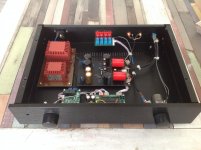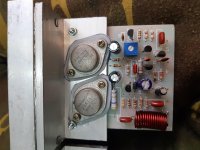I'm among the very last to quibble with Pete Millett's work. The 12B4 is another nice low mu triode and numerous designs employing it are available.
Getting the end to end gain structure right is a very big deal. It makes little sense to amplify a signal only to attenuate it at the I/P of the next unit in the chain.
Passive control centers can work well, especially where a pentode is used as the voltage gain device of the power amplifier. Given its small CMiller, a pentode allows safe use of a large grid to ground resistance, which lightly loads the potentiometer. Unfortunately, passive control centers always lack flexibility. They are inherently high impedance, with extremely poor load driving capability. Cabling must be very low capacitance (read short and unshielded).
When load driving capability is desired, but gain is unnecessary or undesirable, a buffered control center shines brightly.
The old story of 1 size NOT fitting all is, again, present.
Getting the end to end gain structure right is a very big deal. It makes little sense to amplify a signal only to attenuate it at the I/P of the next unit in the chain.
Passive control centers can work well, especially where a pentode is used as the voltage gain device of the power amplifier. Given its small CMiller, a pentode allows safe use of a large grid to ground resistance, which lightly loads the potentiometer. Unfortunately, passive control centers always lack flexibility. They are inherently high impedance, with extremely poor load driving capability. Cabling must be very low capacitance (read short and unshielded).
When load driving capability is desired, but gain is unnecessary or undesirable, a buffered control center shines brightly.
The old story of 1 size NOT fitting all is, again, present.
Last edited:
Hi Eli. I think PackProtector had a 12B4 preamp at one of the AK fest and "I think" he said it had a gain of 20 which in some cases might be too much.
The other 'hot' preamp circuit is Salas' 6V6-triode line amp. There are several versions, and it sure does get a lot of love. Be warned, it's a long thread.
My apologies if this has already been mentioned.
--
My apologies if this has already been mentioned.
--
My current favorite 'line preamp' is actually an input selector and an Intact Audio autoformer/inductive attenuator for volume control. I think it does great things for the sound of my setup. It is an expensive volume control, but in this case I think ya git whut ya pays fer. Some may vehemently disagree. That's fine.
intact audio
intact audio
I built the passive voltage amp (PVA) designed by Electraprint. I used a 10k DACT pot with the transformers. Works well with CD. Bil
Still difficult to beat a SLCF and relatively simple if you forgo the phono stage and the super regulators. Been my standard now for years.
Passive preamps can shine in s limited range of applications but will generally have fairly weak bass in my experience.
Peter Millets low Mu preamp is just ridiculous overkill.
Shoog
Passive preamps can shine in s limited range of applications but will generally have fairly weak bass in my experience.
Peter Millets low Mu preamp is just ridiculous overkill.
Shoog
buffer->volume pot/or rather, volume selector rotary switch->buffer..
running from a battery.
its supposed to be good.
running from a battery.
its supposed to be good.
......autoformer in stepup mode, does some voltage gain (passive pre-)
as some already said, nowadays sources can clip most amps without a problem, so step up is probably not necessary
OTOH, after thinking for a long time about a nice driver with 6dB gain between a DAC (low output impedance) and active Xover (with 1M input impedance), I 0pted for a 1:2 step up transformer - a step up autoformer could have been a nice option as well!
If you need some gain i prefer a 6n16 preamp with srpp firststage and cathode folower second stage. Max gain 12x .
We did abx testing with cd, volumecontrol, ncore, dynaudio and cd, volumecontrol, 6n16 preamp with resistor devider so gain is 1x, ncore dynaudio.
People(14) could not hear the difference. Preamp is published on diyaudio.
We did abx testing with cd, volumecontrol, ncore, dynaudio and cd, volumecontrol, 6n16 preamp with resistor devider so gain is 1x, ncore dynaudio.
People(14) could not hear the difference. Preamp is published on diyaudio.
Attachments
Last edited:
Hi Eli. I think PackProtector had a 12B4 preamp at one of the AK fest and "I think" he said it had a gain of 20 which in some cases might be too much.
From the outside it is impossible to tell the difference, but that old linestage was running 12A4. 10kOhm plate loads on I-don't-remember how many Agilent red LED's for bias.
cheers,
Douglas
If you need some gain i prefer a 6n16 preamp with srpp firststage and cathode folower second stage. Max gain 12x .
We did abx testing with cd, volumecontrol, ncore, dynaudio and cd, volumecontrol, 6n16 preamp with resistor devider so gain is 1x, ncore dynaudio.
People(14) could not hear the difference. Preamp is published on diyaudio.
Do you have more info about this preamp?
Please share a simple and Bipolar or mosfet preamp
Please share a simple and Bipolar or mosfet preamp
Please share a simple and Bipolar or mosfet preamp
Please share a simple and Bipolar or mosfet preamp
This is the tube amp forum - you should ask this on the solid state forum.
The most simple and great sounding line amp i have build had 1 tube for both channels (ECC88 or similar).
Anode resistor was 2k2 and cathode was connected with a 1N4007 diode to ground.
The power supply voltage was just under 100V. I used a little feedback as the gain was too much but you can experiment with that.
Anode resistor was 2k2 and cathode was connected with a 1N4007 diode to ground.
The power supply voltage was just under 100V. I used a little feedback as the gain was too much but you can experiment with that.
I whipped together something like that, a single ECC88 as an 'anode follower' (common cathode with local plate-to-grid feedback). I put enough NFB to get the gain down to 3X (about 10dB), which is about an 8x reduction in gain from NFB (-18dB). It works surprisingly well, but it would still have a hard time driving a relatively low impedance input (like a 10k ohm volume control on the front of a Class D amp). Put a source follower after the 'anode follower' and take the feedback off the buffer's output (after the output capacitor) back to the tube grid (input) and now it will drive long cable runs and low impedance loads very well.
On the ECC88 I used Ebb = 160V, Ra = 22k, and an amber LED in the cathode (about -2V bias), which yields about 3mA of Ia.
On the ECC88 I used Ebb = 160V, Ra = 22k, and an amber LED in the cathode (about -2V bias), which yields about 3mA of Ia.
Last edited:
As i had the volume control build in front of this little amp therefore i could drive the poweramp directly. This had a 220K input resistance. I also used plate to grid feedback. It was surprisingly good. I found when lowering the plate resistor value the music "opend up" becoming more 3D. I used a power transformer of 36V and used a voltage doubler. The result was something like 95V. Because of the grid to plate feedback loop it is important to shield the grid resistors and wiring well.
Last edited:
- Home
- Amplifiers
- Tubes / Valves
- Current best DIY preamp?

